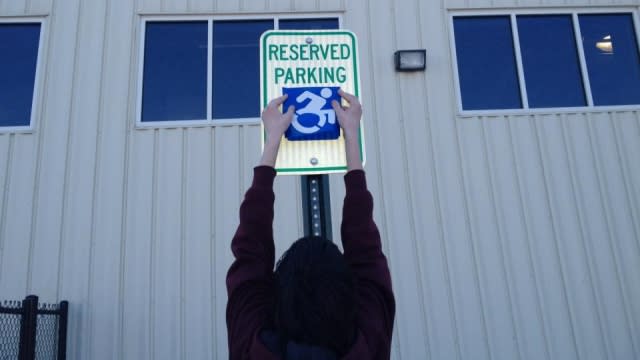There's a movement to change the way we see handicapped signs

"When I interact with people with disabilities they are beautiful," Brian Glenney said.
Graffiti artist and philosophy professor Brian Glenney is among activists who aren't proponents of the stagnant wheelchair user displayed in the international symbol of accessibility.
READ MORE: Peppier handicapped symbol gets support, but problems remain
So they're proposing one showing a wheelchair user in motion, something they say is more representative than the emblem that's been used for the past 50 years.
"The only way for our symbol to actually have any traction in the urban environment is for it to take on a similar look as the old symbol of international access. That's why we have to use a chair," Glenney said.
See how the new signs compare to current signs:
One group, The Accessible Icon Project, started implementing this idea first through transparent stickers to "correct" current signs, which Glenney helped design.
%shareLinks-quote="We want to see the icon stand for funding, rights provisions and guarantees, policies, and overall better conditions for people with disabilities." type="quote" author="The Accessible Icon Project" authordesc="" isquoteoftheday="false"%
And it's slowly gaining traction, but a recently proposed bill in Connecticut's House could be a positive push. The state's new signs would include The Accessible Icon Project's symbol and, instead of "handicapped parking," would read "reserved parking."
If it passes, the Connecticut bill would phase the signs in slowly, which wouldn't add extra costs to taxpayers.
But there have been skeptics. Some disability organizations are against displaying a wheelchair user who isn't representative of users who can't move their arms.
"We fully support any effort to use other symbols that designate kind of universal access," Glenney said.
In 2014, New York passed legislation to update signs. And the Museum of Modern Art in New York City had the icon on display. Various cities around the globe have also adopted the symbol.
The Accessible Icon Project's website says, "Our symbol speaks to the general primacy of personhood, and to the notion that the person first decides how and why s/he will navigate the world."
More from AOL.com:
Here's the MTA's new anti-hoverboard ad
World Trade Center transit hub to open, a New York phoenix rising
What expiration dates really mean
